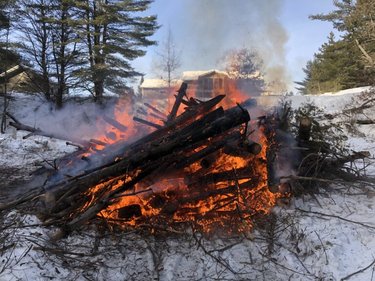DEC: Burning brush nixed till May 14
— Photo from Wisconsin Department of Natural Resources
Even though some areas of the state remain blanketed in snow, warming temperatures can quickly cause wildfire conditions to arise, the DEC says, noting that open burning of debris is the single largest cause of spring wildfires in New York state.
The annual statewide ban prohibiting residential brush burning begins March 16 and runs through May 14.
Since 2009, the state’s Department of Environmental Conservation has enforced the annual brush-burning ban to prevent wildfires and protect communities during heightened conditions for wildfires.
Violators of the open burning regulation are subject to criminal and civil enforcement actions, with a minimum fine of $500 for a first offense.
“This winter was warmer and drier than most, but regardless of the winter weather, we are always at a greater risk of wildfires in the spring,” said Conservation Commissioner Basil Seggos in a March 9 release, announcing the ban. “This ban helps protect our communities, natural resources, and the rangers and other firefighters who extinguish the fires. We’re encouraging all New Yorkers to think about safety first, before starting a potentially dangerous fire.”
Even though some areas of the state remain blanketed in snow, warming temperatures can quickly cause wildfire conditions to arise, the DEC says, noting that open burning of debris is the single largest cause of spring wildfires in New York state. When temperatures warm and the past fall’s debris and leaves dry out, wildfires can start and spread easily, further fueled by winds and a lack of green vegetation.
Each year, DEC Forest Rangers extinguish dozens of wildfires that burn hundreds of acres. In addition, local fire departments, many of which are staffed by volunteers, often have to leave their jobs and families to respond to wildfires caused by illegal debris fires, the release said.
The DEC will post the Fire Danger Map for the 2023 fire season on its website once there is a moderate risk anywhere in New York.
The regulations allow residential brush fires in towns with fewer than 20,000 residents during most of the year, but prohibit such burning in spring when most wildfires occur. Backyard fire pits and campfires less than three feet in height and four feet in length, width, or diameter are allowed, as are small cooking fires.
Only charcoal or dry, clean, untreated, or unpainted wood can be burned. People should never leave these fires unattended and must extinguish them. Burning garbage or leaves is prohibited year-round in New York state.
More information about fire safety and prevention is available on the DEC’s FIREWISE New York webpage.



